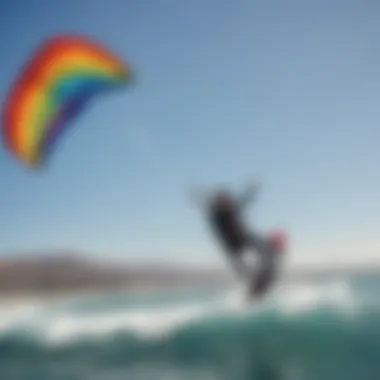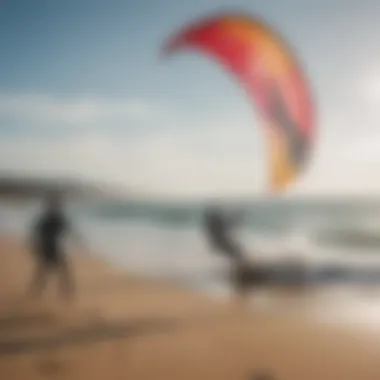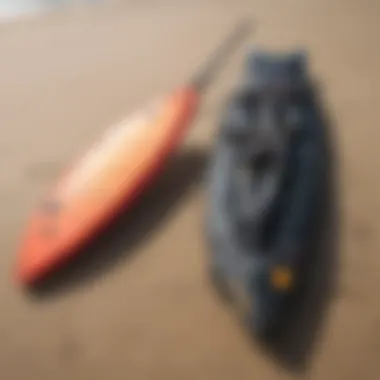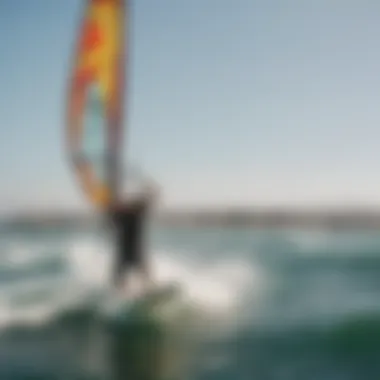Complete Guide to Kite Surfing Lessons in Los Angeles


Intro
Kite surfing, a thrilling combination of surfing and flying, has gained massive traction along the sunny shores of Los Angeles. This sport not only offers an adrenaline rush but also connects enthusiasts with the beauty and power of the ocean. Whether you're a seasoned surfer or a complete novice, understanding the intricacies of training is paramount. In this guide, we’ll take a close look at the kite surfing lessons available, what gear you’ll need, and some tips to hone your skills.
With bustling beaches like Venice and Santa Monica as the backdrop, LA presents a unique opportunity to learn and engage with this sport. However, kite surfing comes with its challenges, and having a good grasp of essential safety practices and gear is crucial. So buckle up as we roll up our sleeves and dive into this comprehensive guide.
Gear Insights
Kite surfers know that the right equipment can make or break your experience on the water. Whether you’re looking to get the basics down or aim to perform like a pro, a good understanding of gear is your first step.
Latest Gear Reviews
When selecting gear, options abound. Let’s explore a few standout pieces that’ve caught the attention of many kite surfers:
- Kite Size: The size of the kite is essential. A popular choice is the Duotone Rebel. It’s revered for its stability and easy handling in varying wind conditions.
- Board Selection: Look for a versatile board like the Liquid Force Drive, which strikes a balance between maneuverability and speed.
- Harness Comfort: A proper harness is key for a comfortable session. The Mystic Warrior offers solid support without compromising on freedom of movement.
These products are highly regarded, yet it's crucial to consider your unique requirements. Not every setup will suit every rider. Carry out thorough research and perhaps seek opinions from local kite surfing communities online.
Essential Gear for Beginners
For those dipping their toes into kite surfing for the first time, getting the right initial gear is vital. Below is a simplified list for beginner kite surfers:
- Kite: A smaller kite generally offers more control; look for something in the 7-9 meter range.
- Board: Opt for a beginner-friendly board with ample width for stability, such as the Best Whip.
- Safety Gear: Never skimp on safety. A helmet and impact vest are non-negotiable.
- Lessons: Consider starting with an experienced instructor who can walk you through the basics and tailor your experience to your skill level.
Techniques and Tips
Once you’ve got the gear sorted, it's time to focus on enhancing your skills and ensuring your time on the water is both enjoyable and safe.
Advanced Tricks and Techniques
As your confidence grows, you may want to take your skills up a notch. Tricks like the back roll or jump require a solid framework of basics, so practice makes perfect here. Here are a few tips to assist you:
- Watch the Wind: Understanding the wind direction can help you time your jumps better.
- Body Positioning: Maintain a low center of gravity when attempting maneuvers to improve stability.
- Practice Regularly: Consistency is key. Regular practice will help refine your technique and build muscle memory.
Safety Practices for Kiteboarders
Even the most exhilarating sport has its risks, and kite surfing is no exception. Thus, taking precautionary measures is paramount.
"Safety is no accident."
While it's a simple phrase, it encapsulates the essence of kite surfing.
Consider these safety tips:
- Always Check Gear: Before heading out, inspect your equipment thoroughly for any damage.
- Stay Aware: Being alert to other surfers and obstructions is essential.
- Know the Rules: Familiarize yourself with local guidelines regarding kite surfing, especially in crowded areas.
By following these guidelines, beginners will set themselves up for a stronger journey into kite surfing, while seasoned surfers can refine their craft and enjoy the waves to the fullest.
Prelims to Kite Surfing
Kite surfing, a dynamic blend of surfing, sailing, and wakeboarding, offers not just a thrilling water sport but an avenue for self-expression and adventure. Its rising popularity can be attributed to the sense of freedom it imparts, allowing enthusiasts to glide across the water, dancing with the wind. In this section, we delve into the fundamentals of kite surfing, shedding light on its significance, characteristics, and the exhilarating allure that draws so many people to the sport.
Defining Kite Surfing
Kite surfing combines aspects of different watersports, using a massive kite to harness the power of the wind while riding a board over water. Practitioners, often referred to as kiteboarders, launch their kites horizontally, controlling flight through lines tethered to the board. Unlike traditional surfing that relies on ocean waves, kite surfing gives its riders the ability to maneuver through flat water, waves, or even spots like lagoons, thereby offering various experiences based on conditions.
The setup usually involves a board, a kite, a harness to connect the rider to the kite lines, and safety gear. It’s crucial to note that kite surfing often requires training due to the potential danger if not practiced correctly. Understanding how to handle the kite, gauge wind conditions, and recognize safety protocols are essential for novices.
The Appeal of Kite Surfing
There’s a unique allure to kite surfing that attracts thrill-seekers and serene adventurers alike.
- Empowerment through Skill: Learning to kite surf provides a sense of achievement. Each progress from basic maneuvers to advanced tricks boosts confidence and self-esteem.
- Connection with Nature: The sport immerses riders in natural surroundings – wind, water, and sunlight. Many find this connection invigorating, blending physical activity with mental relaxation.
- Social Network: Engaging in kite surfing often leads to meeting a community of fellow enthusiasts. This shared passion fosters camaraderie and friendship, enriching the overall experience.
- Versatile Fun: No matter the individual's skill level or preferences, kite surfing offers a spectrum of activities – freestyle, jumping, and even racing. The diverse landscapes and conditions in Los Angeles amplify this appeal, providing varied settings for kite surfing.
"Kite surfing isn’t just a sport; it’s a lifestyle. The thrill is in the ride, but the connections made and the experiences shared are what truly make it special."
As we progress through this guide, we’ll discuss kite surfing in Los Angeles, spotlighting local schools, necessary gear, safety guidelines, and how to engage with the thriving kite surfing community. This exploration paves the way for both beginners eager to learn and seasoned kiteboarders looking to refine their skills.
Kite Surfing in Los Angeles
Kite surfing in Los Angeles is much more than just a trendy sport; it's a way of life for many enthusiasts living in this vibrant coastal area. The blend of ideal conditions, buzzing community, and picturesque locations makes LA a standout choice for both newcomers and seasoned kite surfers. From the ocean's rhythmic waves to the thrilling sense of freedom as one slices through the sea, engaging in this sport here is a captivating experience.
Why Choose Los Angeles?
Los Angeles boasts an incredible variety of kite surfing opportunities that draw adventure seekers from all corners. The unique geography of this bustling city means there’s an abundance of beaches with varying conditions suited for all skill levels. What's more, the cultural melting pot that is LA fosters a diverse community of kite surfers who share not just their passion for the sport, but also their knowledge and skills.
The area provides a healthy mix of beginner-friendly spots, as well as demanding conditions that will challenge even the most experienced riders. A prime example is the renowned Venice Beach which offers consistent wind conditions, making it the perfect playground for enthusiasts.
Moreover, the iconic scenery—California sun setting over the ocean—makes every session feel like a scene from a movie. There, you can soak it all in and enjoy the ride, surrounded by like-minded individuals who are just as eager to hit the water.
Local Weather and Wind Conditions


When considering kite surfing, understanding local weather and wind patterns is crucial. Los Angeles experiences a Mediterranean climate, characterized by warm, dry summers and mild, wet winters. The kite surfing season typically peaks from late spring through early fall. During these months, steady winds can be expected along the coastline, especially in the afternoons when the sea breeze kicks in.
Key wind factors to note in LA include:
- Thermal Winds: These winds regularly pick up in the afternoons due to the temperature differential between the land and ocean. They can reach speeds of 12-20 knots, ideal for kite surfers.
- Coastal Patterns: Different beaches can experience varied wind conditions. It's advisable to check local forecasts or consult seasoned kite surfers for intel on the best times to hit the water.
- Avoiding Outliers: Adverse weather can happen, but resorts and schools often monitor conditions carefully. Always ensure to verify before heading out.
Top Kite Surfing Locations
Los Angeles is dotted with fantastic kite surfing locations, each offering something unique to surfers of varying levels.
- Venice Beach: A gateway to the kite surfing scene, Venice Beach is famous for its consistent winds and bustling ambiance. Perfect for learners and veterans alike.
- Santa Monica Beach: Here, the stunning backdrop of the Santa Monica pier complements the shores. Though it can get crowded, it's a hotspot for experienced riders during the right wind conditions.
- Dockweiler State Beach: This location caters especially to more advanced kite surfers. The beach provides ample space to launch and land kites, with fewer crowds than Venice or Santa Monica.
- El Puerto: Located a bit further south, this locale experiences strong and reliable winds, making it an excellent choice for those looking to sharpen their techniques without distractions.
- Pismo Beach: Respected for its scenic beauty, this beach offers great conditions, particularly during spring and summer.
By selecting a location that aligns with your skill level and preferences, you can significantly enhance your kite surfing experience.
As you navigate your journey into the world of kite surfing, remember that Los Angeles presents not only the perfect atmosphere and community, but an adventure that blends sport with breathtaking scenery in a way few other places can.
Finding the Right School
When embarking on your kite surfing journey, selecting an appropriate school is like laying the foundation for a sturdy house. The quality of instruction not only determines how quickly you’ll advance but also affects your safety and overall enjoyment of the sport. In a bustling place like Los Angeles, you'll find a multitude of options. Therefore, diving into the intricacies of finding the right school becomes paramount. By examining instructors' credentials, lesson structures, and pricing models, you can ensure that your experience aligns with your expectations and skill level.
Evaluating Instructors and Credentials
The cornerstone of any kite surfing school is its instructors. Their expertise should be easily verifiable. Look for certifications from recognized organizations like the International Kiteboarding Organization (IKO) or the American Kiteboarding Association (AKA). These bodies ensure that instructors adhere to safety standards and teaching protocols.
It's not just about having a certificate, though. A good instructor also possesses experience in dealing with varied weather conditions and diverse student needs. Engaging with past students or reading online reviews can help you get a clear picture. Sometimes, just chatting with an instructor can give you insight into their teaching style. Consider asking about their personal kite surfing experiences and how they approach lesson adaptations for different learners.
Comparing Lesson Structures
Once you've narrowed down potential schools based on instructor credentials, the next step is to look into the lesson structures they offer. Each school has its approach to teaching, whether through group sessions, one-on-one instruction, or a hybrid model. Here are a few aspects to consider:
- Curriculum Depth: Some schools offer a structured curriculum that progresses through various skill levels, while others may adopt a more freestyle, student-driven approach.
- Lesson Duration: Classes can range from intense half-day sessions to more leisurely three-hour ones. Your choice may depend on your learning style and time commitment.
- Practical vs. Theoretical: It's vital to assess how much time is spent on actual water time compared to learning about gear and safety on land. Ideally, you want to maximize time spent mastering techniques on the water.
"The right lesson structure can mean the difference between struggle and glide."
Understanding Pricing Models
Another critical consideration is the pricing model of the schools you’re interested in. Lessons can vary greatly in cost and structure. Here are some common pricing elements to keep in mind:
- Hourly Rates: Some schools may charge hourly, while others might offer package deals that can save you money in the long run.
- Group vs. Private Sessions: Group lessons might be less expensive and provide a social atmosphere, whereas private sessions offer a tailored approach at a premium rate.
- Membership Deals: Investigate if schools offer membership or loyalty programs that can reduce costs for regular students.
Understanding these financial frameworks can aid you in deciding which school aligns best with your budget and learning goals.
Choosing the ideal kite surfing school can feel intimidating, but breaking it down into these components can simplify the process. By paying attention to instructors' qualifications, lesson structures, and pricing models, you align your kite surfing endeavors with the right foundation, ensuring a safer and more gratifying adventure on the water.
Types of Lessons Available
When diving into the world of kite surfing, understanding the types of lessons available is crucial. Each option caters to different learning styles and skill levels, providing either collaborative or individualized experiences. These lessons not only teach the fundamental techniques needed but also ensure that each kiteboarder develops a strong foundation in safety practices and equipment handling.
Group Lessons
Group lessons offer an exciting environment for those new to kite surfing. Typically tailored for small groups, this option allows individuals to share the learning experience with peers. The sense of camaraderie can help build confidence and provide instant encouragement.
- Benefits of Group Lessons:
- Cost-Effective: Group sessions are usually more affordable. With the costs shared across participants, students get to learn without breaking the bank.
- Social Interaction: Learning alongside others means motivation and fun. New friendships and kite surfing buddies can often blossom from these sessions.
- Team Learning: Students can learn from each other's mistakes and successes, gaining varied perspectives on the same techniques.
However, it’s important to keep in mind that personal attention might be limited. Some may find it challenging to get specific feedback due to the instructor's divided focus among multiple students.
Private Lessons
For those who prefer a more tailored approach, private lessons can be the way to go. They are designed for individuals or small groups of friends, providing a customized learning experience. Depending on the instructor's assessment, lessons can target specific skills or techniques, allowing for a focused progression in practice.
- Benefits of Private Lessons:
- Personalized Instruction: Individualized feedback and tailored lesson plans help students progress at their own pace. This can be particularly advantageous for those who learn better in a one-on-one setting.
- Flexible Scheduling: Unlike group lessons, which often have set times, private lessons offer more flexibility. Students can book sessions that fit their schedules without the need to coordinate with others.
- Immediate Feedback: Instructors can give real-time corrections, helping students to overcome challenges more swiftly.
It's worth noting that private lessons can be pricier, but the investment might be worth it for serious learners aiming to fast-track their skills.
Advanced Coaching Options
Once foundational skills are in place, many kite surfers may seek advanced coaching to refine their technique or learn new tricks. Advanced coaching options can vary greatly, from specialized clinics focusing on freestyle or wave riding skills to one-on-one sessions dedicated to performance optimization.
- Benefits of Advanced Coaching:
- Expert Guidance: Coaches often bring vast competitive experience and can help athletes reach their full potential.
- Targeted Skill Development: Advanced sessions can be focused on specific areas such as jumps, turns, or tricks that may be harder to nail down without expert input.
- Performance Analysis: Off-the-water feedback, including video analysis, can help students understand their movements and identify areas needing improvement.
Whether you choose group lessons for the fun atmosphere, private lessons for personalized attention, or advanced coaching for nuanced development, each type of lesson can play a pivotal role in your kite surfing journey. Whatever you decide, the key is to pick a lesson structure that resonates with your learning style and skill aspirations.
"Choosing the right type of lesson is not just about learning to kite surf; it’s about creating an experience that allows for growth, confidence, and enjoyment."
As kite surfing secrets unfold, understanding lesson types shows you the right path to follow as you embark on this exhilarating adventure.


Essential Gear for Kite Surfing
When it comes to kite surfing, having the right gear can make or break your experience. While the thrill of harnessing the wind to skim over waves is undeniable, the necessity for proper equipment cannot be overstated. Safety, comfort, and performance all hinge on quality gear. Let’s break down the essential elements that every kite surfer should consider.
Kites and Boards
Kites are the heart and soul of the sport. Choosing the right kite involves understanding various aspects such as size, shape, and intended use. For instance, a larger kite generates more power and lift, making it ideal for lighter winds, while smaller kites are preferable in strong winds. When it comes to shape, there are options like delta kites and bow kites, each serving different skill levels and styles.
Boards come in a range of sizes and designs tailored for different riding conditions. Freestyle boards, for example, are shorter and lighter, perfect for tricks and jumps, whereas freeride boards are typically longer, providing stability and glide, suitable for all-around riding.
Here’s a quick summary of what to look for:
- Kite Size: Larger for light winds; smaller for strong winds
- Kite Shape: Delta for stability; bow for versatility
- Board Type: Freestyle for tricks, freeride for all conditions
Harnesses and Safety Gear
Often overlooked, harnesses are crucial in kite surfing, serving as the primary point of connection between the rider and the kite. A well-fitting harness ensures maximum control and comfort, allowing for better performance. There are two main types: seat harnesses, which provide lower back support, and waist harnesses, which allow for unrestricted movement.
In addition to harnesses, safety gear is indivisible from the sport. A proper safety leash connects you to your kite, ensuring it remains tethered and preventing it from flying away in strong winds. Investing in a reliable impact vest not only provides buoyancy but also adds an extra layer of protection during falls.
Key points include:
- Harness Fit: Comfort is paramount
- Safety Leash: Prevents kite loss
- Impact Vest: Protects from falls and adds flotation
Wetsuits and Accessories
Given that kite surfing often involves cold water or extensive sun exposure, wearing a wetsuit becomes essential, especially during colder months. Wetsuits help regulate body temperature while providing some protection against abrasions and board impacts. Thickness and material are important; a 3/2 mm wetsuit generally suffices for temperate waters, while colder regions may necessitate a thicker suit.
Accessories also play a vital role in enhancing your kite surfing experience. Footwear is essential, with booties providing grip and warmth, particularly in colder waters. A good pair of sunglasses with straps are indispensable for daytime sessions, preventing glare from the sun and protecting your eyes.
Take note of these essentials:
- Wetsuit Thickness: Adjust based on water temperature
- Footwear: Booties for warmth and grip
- Sunglasses: Essential for eye protection in sunlight
"Kite surfing is not just a sport; it’s an art form that blends technique, passion, and nature."
With the right gear, kite surfing transforms into a safe and enjoyable adventure. It’s a commitment that pays off in spades as you ride the winds and waves of beautiful locations, such as the coasts of Los Angeles.
Safety Considerations
Safety is a cornerstone of kite surfing. This article takes a deep dive into essential safety aspects that every prospective kite surfer must consider. While the thrill of zipping across the water and feeling the wind against your skin can be exhilarating, understanding the potential risks and how to navigate them is crucial for an enjoyable experience. From recognizing hazardous conditions to adhering to community-driven safety protocols, these considerations are vital for both beginners and seasoned enthusiasts.
Understanding Risks
Kite surfing, as breathtaking as it is, carries its share of risks. Inherent risks arise from various factors such as wind conditions, water currents, and even the equipment itself. One must be constantly aware that conditions can change rapidly. For example, a seemingly perfect day on the beach can turn into an unforeseen storm with powerful gusts.
- Equipment Failure: This includes kite malfunctions or issues with control bars. Make sure every piece of gear is inspected regularly.
- Environmental Hazards: Rocks, reefs, and sudden waves can be hazards, especially in unfamiliar waters. Knowledge of the local geography is essential.
- Collisions: Other surfers, swimmers, or boats can pose risks, especially in crowded locations. Always maintain awareness of your surroundings.
By acknowledging these risks, you can take informed steps toward minimizing them, enabling a safer kite surfing experience.
Safety Protocols During Lessons
When participating in kite surfing lessons, strict adherence to safety protocols is paramount. These are not just recommendations; they are practices to ensure a safe learning environment. Here are key aspects to consider:
- Pre-Lesson Briefing: Instructors should provide a thorough understanding of safety procedures before hitting the water. This includes how to launch and land a kite safely.
- Emergency Signals: Each school should teach standard hand signals or whistles used for communication on the water.
- Buddy System: Engaging in lessons with a partner can enhance safety. Having someone nearby to assist in emergencies can be invaluable.
- Practice Aftercare: After a lesson, students should reflect on what they learned regarding safety techniques to reinforce those skills for future outings.
These protocols not only help mitigate risks but also foster confidence in new kite surfers.
Local Regulations and Code of Conduct
Familiarity with local regulations and the unwritten code of conduct is essential when kite surfing in Los Angeles. These guidelines evolve from local community norms, surf etiquette, and even environmental laws, which are designed to protect both surfers and the coastal ecosystem. Here are several points to keep in mind:
- Respecting Designated Zones: Specific areas may be reserved for kite surfing, while others may be off-limits. Make sure to check local signage and maps to avoid misunderstandings.
- Wildlife Protections: Some areas have restrictions to protect marine wildlife. Always observe posted guidelines regarding endangered species or protected habitats.
- Navigating Crowded Waters: When in areas with other water users, always yield the right of way to those who are already riding. Keeping everyone safe requires consideration for those around you.
"Knowing the rules is as essential as knowing how to kite surf; it's part of being a responsible participant in this exhilarating sport."
Engaging with the kiteboarding community can also provide insights into these regulations, enriching one's learning experience while ensuring compliance with safety standards.
By understanding these core safety considerations, anyone interested in kite surfing can significantly enhance their enjoyment of this stunning sport while minimizing potential setbacks.
Community and Networking Opportunities
Creating connections within the kite surfing community can be a game-changer for enthusiasts in Los Angeles. It’s not just about hitting the waves solo; engaging with fellow kiteboarders brings a deeper understanding of the sport. Networking provides avenues for skill development, shared experiences, and lasting friendships. The kite surfing culture in LA is vibrant, and being part of it enhances not just skills but also enjoyment of the sport.
Joining Local Kiteboarding Groups
Being part of a local kiteboarding group is akin to having your very own cheering squad. In Los Angeles, groups like the Los Angeles Kiteboarding Association offer a supportive environment where both newcomers and seasoned veterans can mingle.
- Meet New Friends: Kiteboarding communities foster friendships formed over shared passions. Meeting people who appreciate the stoke of the wind and sea can lead to lasting relationships.
- Knowledge Exchange: Local meetups mean you have access to a wealth of information. Whether it’s the best spots for kiteboarding or tips on gear, group members often share valuable insights that go beyond tutorials.
- Skill Progression: Observing others can significantly boost your own progress. With various skill levels available, joining a group allows for mentorship opportunities that are invaluable for beginners.


Participating in Events and Competitions
Tapping into events and competitions in kiteboarding can elevate your skills and confidence. Los Angeles hosts numerous events that cater to kite surfers of all skill levels. Participating in these can be both exhilarating and educational.
- Competitions: Competing against peers is one of the best ways to measure your skills. Events organized by local schools or communities often welcome participants from all backgrounds. They provide a structured environment to test oneself under friendly competition.
- Festivals and Community Days: Many kite surfing events also celebrate the sport through festivals. These gatherings not only entertain but also bond communities, showcasing talent and fostering a spirit of togetherness.
- Hands-On Learning: Workshops during competitions can offer targeted coaching on advanced techniques or safety practices—useful knowledge that might otherwise take a long time to acquire on your own.
Exploring Online Communities
The digital sphere has exploded in recent years, making it easier than ever to find kite surfing communities online. Platforms like Reddit, Facebook, and various kiteboarding forums act as hubs for sharing information, experiences, and advice.
- Global Connections: Unlike local groups, online communities give you access to enthusiasts from different parts of the world. This can provide unique perspectives on techniques, conditions, and styles that vary by region.
- Resource Sharing: Members frequently share articles, videos, and tutorials that prove useful for daily practice. These resources can be crucial for those looking to refine their skills from home or during off-seasons.
- Discussion & Support: Whether it’s a question about gear or tackling a new trick, online forums can supply the support and feedback necessary to build confidence. It creates an ongoing dialogue that can motivate you to push your limits.
In summary, engaging with local and online kite surfing communities can enrich your learning experience tremendously. By joining groups, participating in events, and exploring digital networks, you'll find yourself surrounded by a support system that enhances not just skill but also passion for kiteboarding.
Traveling for Kite Surfing
Traveling for kite surfing isn’t just a way to spice up your routine; it’s an invite to a world where wind, waves, and the thrill of the chase meet. By venturing beyond Los Angeles, kiteboarders can discover unique cultures, unravel pristine beaches, and experience different wind conditions that can elevate their skills. Whether you're an ambitious novice or a seasoned surfer, exploring different destinations not only enhances your understanding of the sport but allows for personal growth in ways that staying local simply can't provide.
Kite Surfing Destinations Beyond Los Angeles
Kite surfing is a global passion, with hotspots scattered all around the planet. Some worthy mentions include:
- Hood River, Oregon: Nestled between mountains, Hood River has diverse wind conditions and stunning vistas. It's a mecca for kiteboarders all year long, making it ideal for both beginners and advanced riders.
- Tarifa, Spain: Known as the kiteboarding capital of Europe, Tarifa boasts consistent winds and a vibrant local community. The European vibe mixed with mesmerizing beaches makes it hard to resist.
- Maui, Hawaii: If you crave both adventure and relaxation, Maui is a dream. With creature comforts nearby and incredible waves, it’s perfect for those looking to take their kite surfing skills up a notch.
- Cabarete, Dominican Republic: Famous for its laid-back atmosphere and exceptional wind conditions, Cabarete attracts kite surfing enthusiasts from all over the globe.
Traveling to these spots expands your horizons. You meet people who share your passion and learn from diverse experiences. Each location has its own character and offers lessons that go beyond just the kite, teaching you about local customs and values.
Planning the Perfect Kiteboarding Trip
A successful kiteboarding trip involves more than just packing your gear. To nail down a well-rounded journey, consider the following:
- Research: Dive into books and online resources that offer insights into wind patterns, local laws, and community vibes. Knowing what to expect can save headaches down the line.
- Seasonal Awareness: Every destination shines at different times of the year. For example, Tarifa may be buzzing with wind in the spring, while Cabarete could be best in the summer. Time your visit well!
- Accommodation Considerations: Look for lodgings that cater to kite surfers. Such places often provide secure gear storage, proximity to the beach, and even local guides.
- Connect with Local Schools: Once you arrive, link up with local kite surfing schools. They can offer guided tours, safety briefings, and assessments on conditions that might not be apparent from the shore.
- Emergency Plan: Always have a backup plan. Weather is fickle, and having alternative activities or the flexibility to change locations can be beneficial.
- Sustainable Practices: Embrace eco-friendly practices during your travels. Respect local environments and communities to preserve these beautiful spots for future kite surfers.
By taking time to plan your journey, you'll not only amp up your kite surfing skills but also enjoy a richer experience that could be the highlight of your travel stories.
"Traveling isn’t just about the destination; it’s about the journeys that shape us along the way."
Embrace the call of the winds as you traverse beyond Los Angeles and let the adventure mold your kite surfing skills like the waves sculpting the shore.
Continuous Learning and Improvement
Kite surfing is not just a sport; it is a journey of perpetual growth and skills enhancement. Engaging in this exhilarating activity opens up a pathway to a world where continuous learning becomes paramount. As with many extreme sports, staying static means falling behind. It’s crucial to grasp that kite surfing, like the ocean currents, is ever-changing. From honing your techniques to embracing new tricks, committing to personal development can yield remarkable benefits in your kite surfing adventure.
Setting Personal Goals for Progression
Establishing clear, attainable goals is key to progressing in kite surfing. Whether you’re a novice just getting comfortable on the board or an expert aiming for complex maneuvers, setting personal benchmarks helps in tracking improvements. Here’s how to approach it:
- Identify Your Current Skill Level: Begin by honestly assessing your capabilities. What are your strengths? What do you struggle with? This assessment provides a solid foundation for your goals.
- Define Specific Goals: Instead of vague aspirations like "becoming better," try to pinpoint exact skills you wish to acquire. For example, aim to land a jump consistently or master the transitions between different board positions.
- Create a Timeline: Having a timeframe sets a sense of urgency and can motivate you. Allocate time for practice sessions, and don’t forget you can adjust your timeline based on progress.
- Measure Your Success: At regular intervals, revisit your goals. Did you manage to accomplish what you set out to? Reflect on challenges faced and learn from any setbacks.
Reflecting on your journey continuously lets you build confidence and keeps motivation high.
Finding Advanced Resources and Tutorials
As you move forward in your kite surfing quest, finding advanced learning resources is crucial. The kite surfing community is filled with resources that can help elevate your skills. Here’s where to look:
- Online Tutorials: Websites like YouTube are treasure troves of kite surfing techniques. Channels hosting professional kite surfers often share step-by-step guides on specific tricks or safety practices.
- Forums and Community Groups: Platforms like Reddit or Facebook offer community support. Engaging with seasoned kite surfers can provide insight into lessons learned. You can ask questions, share experiences, or even find mentors.
- Workshops and Camps: Participating in kite surfing camps led by experts can provide hands-on experience and unique coaching that often isn’t available in a traditional lesson setting. These can be invaluable in breaking through to the next skill level.
- Books and eBooks: Seek out literature focusing on kite surfing. There are books available that delve deeper into techniques and the physics of flying kites, enrich your understanding beyond just practical skills.
Remember:
"To be a better kite surfer, one must always be willing to learn"
Cultivating a habit of continual learning enhances your connection with the sport, pushes your boundaries, and instills a deeper sense of accomplishment in your kite surfing journey.
Closure
Understanding the various elements of kite surfing lessons in Los Angeles is essential for both newcomers and seasoned enthusiasts alike. This article has shed light on vital aspects such as finding the right school, recognizing local conditions, and selecting the appropriate gear. These factors not only influence the learning experience but also can determine the effectiveness of skill progression over time.
Committing time to learn kite surfing in Los Angeles allows enthusiasts to immerse themselves in the culture surrounding this thrilling sport. As kite surfing continues to grow, making connections with fellow kiteboarders enriches the journey, opening doors to new opportunities. Engaging with communities and participating in events can add more dimension to the experience, turning a solitary sport into a social adventure.
Ultimately, choosing to embark on this journey is about much more than just mastering the techniques. It's about embracing the thrill of the wind and waves, building confidence, and fostering relationships with like-minded individuals. The pathway may seem challenging at times, but the rewards of understanding the ocean and mastering the kite outweigh the effort.
"Kite surfing not only teaches you how to ride the waves but also how to ride the winds of change in your own life."
As kite surfing in Los Angeles approaches new heights, the commitment to continuous learning and improving can ensure that practitioners remain engaged and ready to take on challenges. With it, the understanding of safety protocols and gear can lead to a fulfilling and safe experience in this adventurous endeavor.
Recap of Key Takeaways
- Essential Knowledge: Familiarity with local conditions and safety practices is fundamental for successful kite surfing.
- Community Connection: Engaging with local kiteboarding communities enriches the experience and promotes skill development through shared knowledge.
- Adaptive Learning: Remembering to set personal goals and continuously seek improvement is key to mastery in kite surfing.
The Future of Kite Surfing in Los Angeles
Looking ahead, the future of kite surfing in Los Angeles appears promising and vibrant. With more people recognizing the joy and thrill this sport brings, opportunities for lessons are expanding rapidly. Schools are likely to innovate their teaching methods, integrating technology to enhance learning.
Additionally, the continued growth of the kite surf community may lead to more organized events, competitions, and opportunities for networking among enthusiasts. Sustainability discussions are becoming a part of the conversation as well, urging practitioners to adopt eco-friendly practices that preserve the beauty and health of coastal environments.
The demand for kite surfing is not showing signs of slowing down. More travelers are seeking unique experiences in Los Angeles, and kite surfing presents an exhilarating option. Given the city’s beautiful coastline and favorable wind conditions, the sport will likely attract even more kiteboarders in the future.
Embracing this evolution ensures that kite surfing remains a joyful pursuit for many. The budding enthusiasm for this sport amidst the backdrop of stunning sunsets and ocean waves will continue to condescend the vivid memories of those who dare to dance with the winds.















